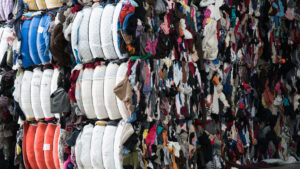Recycled Textiles as a Solution to Overfilling Landfills

Recycled textile is procured through reusing old outfits and waste materials through an array of different treatments. Recyclable textiles are typically found in municipal waste from sources such as waste clothes, footwear, rugs, towels etc. The significance of reusing textiles is highly being recognized. Nevertheless, textile recycling is certainly a prominent challenge to be remitted as we should definitely move closer to a zero landfill circle.
Once dumped in the disposal area, it takes a few weeks or sometimes a few years for natural fibers to degrade properly. They may let out CO2 and methane gas into the blue. At the same time, synthetic textiles are crafted not to putrefy. In the landfill, they may release toxic elements into soil and groundwater.
When it comes to textile recycling, the benefits it provides are numerous indeed. The advantages are as follows:
- Declines landfill space supplies, keeping in mind that clothing made of synthetic textile do not really decay easily and that there remains a chance even for natural fibers to release greenhouse fumes.
- Decreases unnecessary consumption of energy and water.
- Shuns off pollution.
- Finally, gives way to reduced demand for dyes.
Andritz, an Austrian venture, is all set to stock textile recycling tools to a Sweden based green-field reprocessing factory, namely Renewcell. The start-up of the firm is slated for the next year. The Andritz plant happens to provide recycling solutions for an array of different applications such as organic, wood waste, household, and the like.
The prime elements of the new reprocessing method will be Andritz ADuro shredders and it will rip up used textiles in only one tearing up rung. With distinctive abilities, the ADuro shredders will expurgate the incoming material evenly and neatly while allowing a considerably high throughput. In the succeeding separation phases, contaminants like zips, fasteners, and brooches will be drawn out from the frayed textiles. Renewcell utilizes this pre-treated substances to yield an unadulterated and untainted natural dissolving mash made from hundred per cent recycled fabrics & knits. Textile recycling agents across the globe have made a fervent plea for countries to follow the market instance in Africa and cuddle the depletion of used attires and fabrics to creep up on a circular economy.
There is a pretty common fallacy that secondhand outfit shipped to developing economies partly come off being discarded right away. However, the fact is apparels not sold straight in the market simply gets deputed over the supply chain and ends up being vended in other smaller marketplaces throughout the province. Also, it is fair to understand that no lucrative business will ever lay out money on packaging, conveying, and distributing products only to get them heaped in a dumping ground.
As per the experts in this domain, textile recycling is rather the solution than the hiccup. Secondhand attires exported to different regions are classified and assembled for customer preferences and needs. The truth is if apparels don’t sell, they are often dispatched to other markets, may be in some different countries, for exchange or reprocessing; and they are hardly thrown away.
According to Allied Market Research, the global recycled textile market is projected to cite a significant CAGR from 2020 to 2027. The considerable low cost of recycled goods than that of virgin produces has acted as the major driver fueling the growth of the recycled textiles market in more than one way. Also, in the past few years, there’s been huge development in recycling technologies across the world which has paved the way for a plethora of opportunities in the industry.
The fact that recycled polyesters are resistant to chemicals, durable, sturdy, and easy to dye has made them a highly preferred choice in several industry verticals. At the same time, properties such as high strength, good resistance & pliability, and high moisture retrieval capacity make recycled nylon an expedient option too. Furthermore, reprocessing of nylon tends to hold out less energy depletion, waste water reserves, and reduction of CO2 emission. This factor even boosts the demand for recycled nylon yet more.
Here, it’s worth stating that the outbreak of COVID-19 led to extended lockdowns and bans on international trade, which in turn impacted the recycled textile market negatively. Nonetheless, as the government bodies have started easing off the restrictions and mass inoculation drives have been initiated in the majority of countries, the market is expected to recoup soon.